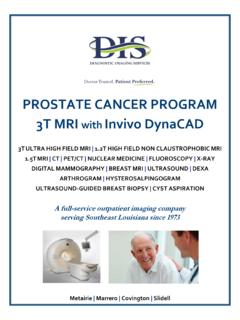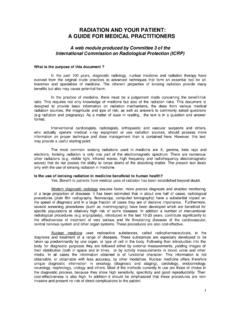Transcription of Adult Routine Preventive Care Recommendations
1 Page 1 of 6 MHQP Adult (1-08)These Recommendations represent a core set of clinical guidelines for average-risk patients from the general population. The guidelines should not supplant clinical judgment or the needs of individual patients. These guidelines are intended as quality-practice Recommendations and are not intended as a description of benefits, conditions of payment, or any other legal requirements of any particular health plan or payor. Each health plan or payor makes its own determination of coverage and benefits. In the event that these practice Recommendations are inconsistent with any applicable laws or regulations, such laws or regulations take MAINTENANCE VISITAt Every AgeObtain initial/interval history, including family history of disease. Perform age-appropriate physical exam. Provide Preventive screenings and counseling as below. Update immunizations. For current immunization schedules, refer to the Centers for Disease Control and Prevention 2007 Adult Immunization Guidelines.
2 Frequency18 29 Years30 39 Years40 49 Years50 64 Years65+ YearsAnnually for ages 18 1 3 years, depending on risk factors for ages 22 1 3 years, depending on risk 1 3 years, depending on risk Annually. LABS AND CANCER SCREENINGSB reast Cancer18 39 Years40 49 Years50 64 Years65+ YearsStarting at age 20, perform clinical breast exam and provide self-exam mammography for patients at high risk. Risk factors include: family history of pre-menopausal breast cancer (mother or sister) and personal history of breast/ovarian/endometrial cancer. Perform clinical breast exam and provide self-exam mammography at discretion of clinical breast exam and provide self-exam clinical breast exam and provide self-exam mammography through age 69; > age 70 at clinician/patient discretion. Cervical Cancer (Pelvic Exam & Pap Test)18 65+ YearsInitiate Pap test and pelvic exam at 3 years after first sexual intercourse or by age 21. If under age 30, perform Pap test annually.
3 Perform pelvic exam and Pap test every 1 3 years, depending on risk factors. Pap test may be performed at 3-year intervals only after 3 consecutive negative results and age 30 or older. Risk factors include: failure to receive regular Pap tests; history of cervical tumors; infection with HPV (human papillomavirus) or other sexually transmitted diseases; high-risk sexual behavior; and HIV/AIDS. The option to omit Pap test after age 65 may be offered if there is documented evidence of consistently negative results. Adult Routine Preventive Care Recommendations /8page 2 of 6 Colorectal Cancer 18 49 Years50 65+ YearsNot Routine except for patients at high risk. Risk factors include: diagnosis in a first-degree relative; specific genetic syndromes; inflammatory bowel disease; and noncancerous polyps. High-risk patients should be screened more frequently using complete colonoscopy at clinician/patient at age 50 and then every 10 years; ORAnnual fecal occult blood test (FOBT) plus sigmoidoscopy every 5 years; ORDouble-contrast barium enema every 5 years; OR Annual FOBT.
4 Each of the screening strategies has advantages and disadvantages. Screen patients after discussion of the effectiveness, strength of evidence, risks, and complexity of each testing strategy to ensure an informed choice. Screening after age 80 at clinician/patient & Prostate Cancer18 39 Years40 49 Years50 65+ YearsPerform clinical testicular exam and provide self-exam instruction at each health maintenance cancer screening not Routine . Perform DRE exam for patients at high risk for prostate cancer. Offer PSA screening for high-risk patients at clinician/patient discretion. Risk factors include family history and African-American DRE exam. Offer PSA screening at clinician/patient Cancer18 65+ YearsPerform skin exams every 3 years between the ages of 20 and 39 and annually age 40 and older, regardless of skin tone and color. Perform skin exams more frequently at clinician discretion based on risk factors, including: age; personal history of skin cancer or repeated sunburns early in life; family history; certain types and a large number of moles; light skin, light hair, and light eye color; sun-sensitive skin; and chronic exposure to the sun.
5 Educate about skin cancer. Counsel to limit exposure to the sun (especially between 10 and 4 ), to fully cover skin with clothing and hats, and to use sun block (SPF 15 or greater).Discourage use of tanning beds. page 3 of 6 SENSORY SCREENINGEye Exam for Glaucoma18 39 Years40 49 Years50 64 Years65+ YearsAt least once in patients with no risk factors. Every 3 5 years in high-risk patients. Risk factors include: African American ancestry, age, family history of glaucoma, and severe annually in patients with diabetes. Every 2 4 annually in patients with 2 4 annually in patients with 1 2 annually in patients with and Vision Assessment18 29 Years30 39 Years40 49 Years50 65+ YearsAsk about hearing and vision impairment, and counsel about the availability of treatment when RECOMENDED SCREENINGBody Mass Index18 65+ YearsScreen for overweight. Consult the CDC s growth and body mass index (BMI) charts. Screen annually for eating disorders.
6 Ask about body image and dieting patterns. Counsel on the benefits of physical activity and a healthy diet to maintain a desirable weight for height. Offer more focused evaluation and intensive counseling for adults with BMI> 30kg/m2 to promote sustained weight loss for obese adults. Cholesterol18 65+ YearsScreen if not previously tested. Screen every 5 years with fasting lipoprotein profile (total cholesterol, LDL cholesterol, HDL cholesterol, and triglyceride). If the testing opportunity is nonfasting and total cholesterol is >200 mg/dl or HDL is <40 mg/dl, a follow up lipoprotein profile should be performed. More Routine screening for patients with high-risk at clinician discretion. High risk includes family history of premature heart disease or hyperlipidemia; hypertension; low HDL; diabetes; tobacco use; and age. If at risk or screened to have high cholesterol and heart disease, counsel on lifestyle changes including a diet low in saturated fats and high in fiber, weight management, and physical activity.
7 Diabetes (Type 2)18 65+ YearsScreen every 3 years beginning at age 45. Screen more often and beginning at a younger age for those who are overweight and if risk factors are present. Risk factors include: age; first-degree relative with diabetes; physical inactivity; race/ethnicity (African American, Hispanic, Native American, Asian); high blood pressure; history of vascular disease; elevated cholesterol/lipid levels; history of gestational diabetes or birth of a baby > 9 lbs; impaired glucose tolerance; or polycystic ovary fasting blood sugar is the preferred diagnostic test. The 2-hour oral glucose tolerance test is also acceptable. Hypertension18 65+ Years Screen for high blood pressure at every acute/nonacute medical encounter and at least once every 2 years. page 4 of 6 Osteoporosis18 29 Years30 39 Years40 64 Years65+ YearsCounsel about Preventive measures, such as dietary calcium and vitamin D intake, weight-bearing exercise, and smoking risk of osteoporosis in all post- menopausal women.
8 Risk factors include: age; female gender; family/personal history of fractures as an Adult ; race (Caucasian/Asian); small-bone structure and low body weight (under 127 lbs.); certain menopause or menstrual histories; lifestyle (smoking, little exercise); and certain medications/chronic on the risks and benefits of hormonal and nonhormonal BMD testing for all postmenopausal women who have one or more additional risk factors for osteoporotic fracture. Provide BMD elderly patients on specific measures to prevent DISEASE SCREENINGS exually Transmitted Infections (Chlamydia, Gonorrhea, Syphilis, & HPV)18 65+ YearsAdvise about risk factors for sexually transmitted infections (STIs) and counsel about effective ways to reduce the risk of chlamydia and gonorrhea:Sexually active male and female patients under age 25: Screen annually. Consider urine-based screening for women when a pelvic examination is not age 25 and over: Screen annually, if at risk.
9 Risk factors include: inconsistent use of condoms and new or multiple sex partners since last test; history of and/or current sexually transmitted infection; partner has other sexual partner(s).For syphilis:Screen if at risk. Risk factors include: history of and/or current infection with another sexually transmitted infection; having more than one sexual partner within the past 6 months; exchanging sex for money or drugs; and men having sex with other men. For HPV:For age 26 and under, if not previously vaccinated, counsel patients regarding the schedule for HPV vaccine. Hepatitis C18 65+ YearsPeriodic testing of all patients at high risk. Risk factors include: illicit injection drug use; receipt of blood product for clotting problems before 1987 and/or receipt of a blood transfusion or solid organ transplant before July, 1992 (if not previously tested); long-term kidney dialysis; evidence of liver disease; a tattoo or body piercing by nonsterile needle; risky sex practices (not using condoms, multiple sex partners).
10 Page 5 of 6 HIV18 65+ YearsRoutine testing of all patients at increased risk. Risk factors include: having received blood or blood products before 1985; men having sex with other men; drug abuse; history of prior sexually transmitted infections; new or multiple sex partners; and inconsistent use of about risk factors for HIV infection. CDC recommends annual testing for those at increased risk and Routine HIV screening for all individuals 13 years of age and (TB)18 65+ YearsTuberculin skin testing for all patients at high risk. Risk factors include: having spent time with someone with known or suspected TB; having HIV infection; coming from a country where TB is very common; having injected illicit drugs; living in where TB is more common ( , shelters, migrant farm camps, prisons); health care worker; or spending time with others with these risk factors. Determine the need for repeat skin testing by the likelihood of continuing exposure to infectious COUNSELING AND GUIDANCEP reconception Counseling18 49 Years50 64 Years65+ YearsAdvise all women of child bearing age take to take a daily multi-vitamin containing.







